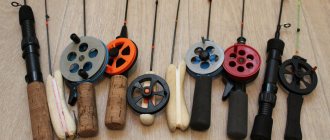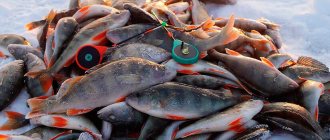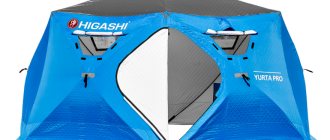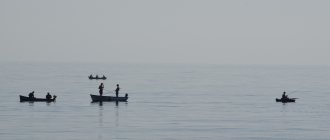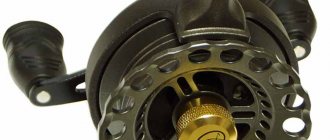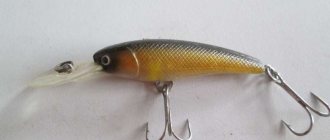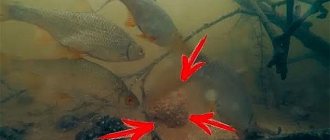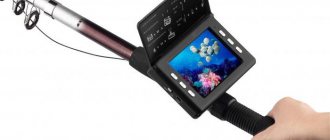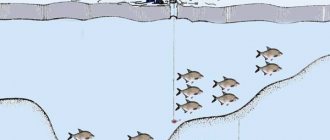☸ What is good about fishing in a tent?
There are many reasons why you should buy such a thing. Of all the advantages of a tent, three main ones can be distinguished.
⚓ Warmth
Fishermen often refuse gloves because they are inconvenient to work with thin fishing line. Bare hands get cold quickly, but not in a tent that retains heat. At a slight minus, human breathing alone is enough to heat it, and at lower temperatures, various heating devices can be used. For example, a gas lamp can keep the temperature 10 degrees higher than “outside”. That is, at -15°C in the tent it will be only -5, which is quite enough for comfortable fishing.
⚓ Wind protection
An air temperature of -10°C in calm weather and the same 10 degrees below zero in combination with a strong wind are two big differences. The faster the cold air moves, the colder a person gets. It feels like at a wind speed of 5 m/s the temperature seems to be the same number of degrees lower. Simply put, in this wind, -15°C turns into -20°C. A tent allows you to hide from the wind in an open space. You don't have to worry about frostbite or any other cold-related problems.
⚓ Stealth
Competitors do not see the fisherman in the tent. This is especially true for inexperienced beginners, who always settle down next to those who are biting well. You can safely fish using secret baits and techniques, and they will never become public knowledge.
How to settle in a tent for the night
The size of a tent for fishing in winter is determined by the number of people in it. In winter, it is better to fish together: there is enough space in the tent, and the night will be more fun. The tent can be either without a bottom or with valves cut into the bottom for holes. The inlet valve must be insulated with a polypropylene foam mat. You need to ensure minimal comfort in the tent. First of all, every fisherman should have a fishing chair or fishing box. A gas camp stove or primus stove for making tea or coffee wouldn’t hurt. A standard army pot fits very well on a primus stove; it is the most suitable vessel for boiling.
How not to freeze and how to organize lighting
It is very important to think about lighting. Illumination with a kerosene lamp or kerosene stove does not justify itself, since their heating begins to melt the ice under the tent. Headlamps have proven themselves to be quite good: they provide bright light, in which you can see both the hole and the “nod” of the winter fishing rod. The downside is that the batteries drain quickly in the cold. You can remove the battery cassette and place it in your pocket, but to do this you need to remake the flashlight by attaching additional wires.
You can make a homemade paraffin lantern. To do this, paraffin must be melted and poured into a large jar with one or more asbestos wicks placed in it. You first need to insert a metal wire with a diameter of 0.5 mm (preferably copper) inside the wick. Such a lantern shines brighter than a simple candle, and it produces so much heat that you can even boil tea on it. The main disadvantage of such a flashlight is too much soot and the risk of burning the fishing line.

Flashlights for night fishing
If you don’t have a lantern, you can make do with candles. Between the two working holes, drill another one (10÷15 cm deep) and insert a candle into it. This is how illumination is carried out in the hole.
A stove for winter fishing is used to heat the tent.
Of course, you need to take care of a solid supply of food, taking into account a good appetite in the fresh air. From alcohol, a little cognac with lemon is recommended: lemon gives vigor and drives away drowsiness.
☸ Types of winter tents
The simplest option is a frame structure consisting of several arches and an awning. Cheap models are equipped with unreliable plastic arches, so it is better to overpay a little and choose ones with metal ones. The main disadvantage of such a tent is its poor stability; it can only be used in calm weather. In addition, it will take some time to install it, and in winter there is not enough time. Before you have time to find a place and settle in, it’s already starting to get dark. But there is a lot of space in it, since the arcs are located outside.

Automatic tents, in particular umbrellas, are very popular among fishermen. Installing them takes just a few minutes, and you can handle this task alone, without the help of a partner. Typically, an umbrella has a streamlined dome shape, which greatly increases its wind resistance. Other advantages include light weight, simplicity of design, the presence of windows for ventilation and durable awning material impregnated with a fire-retardant compound. Buying such a tent will not put a big dent in your pocket. If necessary, it can be moved to another place without disassembling it. It has no significant disadvantages, with the exception of durability. Most of these products are produced in China, and the products of Chinese manufacturers have never been distinguished by their quality. If you set up your tent incorrectly, there is a risk that it will break.
Fishing tactics
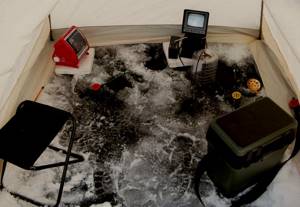
Night fishing differs from day fishing, first of all, in the inactivity of the fisherman and comfort. The place has already been carefully verified, the holes have long been drilled, the tent has been pitched. There is a gas stove burning inside the tent, a lamp is on, and only when you go outside do you realize that winter is all around.
We recommend reading: Winter pike fishing with girders
Tackle
Almost any winter fishing rod is suitable for night bream fishing. It is best to use 2-3 pieces at a time. A larger number will most likely lead to confusion of equipment. And it’s much more difficult to keep track of a large number of floats.
Considering the likelihood of a large bream biting, there is no need to go small with the diameter of the fishing line. A modern fishing line with a diameter of 0.14-0.16 will be sufficient for these purposes.
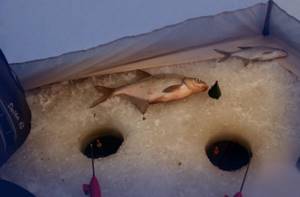
For an assortment, it makes sense to equip each rod differently. For example, you can put a regular jig on one, and a small hook with a sinker on the other. The third fishing rod can be equipped with a so-called rocker, a good bottom rig for catching bream at night.
The fishing itself most often occurs only from the bottom; anglers only occasionally play along with a fishing rod. Fishing occurs in waves, the bite starts suddenly, and ends just as suddenly.
Bait
Bait is mainly used in volumetric form: a bunch of bloodworms, maggots or boiled jigsaw. It can be useful to attach a piece of boiled egg white to the hook. Vegetable attachments work somewhat worse in winter, however, you can attach a piece of bread or semolina. After all, several fishing rods allow you to experiment with bait, and the preferences of bream can change at any time.
Biting and fishing
The bites look like the rise of a float and are quite difficult to miss. At this time, the bream confidently lifts the bait from the bottom and gradually retracts it. There is no point in delaying cutting. As soon as the float began to rise confidently or came to the surface, you need to make a hook.
You need to fish out large fish carefully, trying not to let the line weaken. The greater the depth in the fishing area, the easier it is to control and tire the bream.
Video about catching large bream with an egg
☸ Installation features
Before you start setting up your winter fishing tent, you need to determine which direction the wind is blowing. To prevent it from blowing in, the entrance and ventilation windows should be on the opposite side. After installation, you should rub the zippers with paraffin, otherwise they may freeze. It's even better to do this at home the day before fishing.
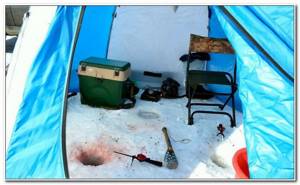
In winter the weather is unpredictable. A sudden gust of wind can interfere with the fishing process and ruin your mood for a long time, so even with complete calm, it’s better to use special threaded fasteners just in case. With this fastening, the “house” will stay firmly on the ice. In addition, it is advisable to cover your skirt with snow, this will increase resistance to wind loads and will not allow the cold to enter from below.
Some fishermen like to drive snowmobiles on hard ice, including in the dark, so it makes sense to equip the tent with reflective elements.
Specifics of fishing
Most large reservoirs are artificially regulated water systems, which makes finding fish much more difficult. Even a slight rise or fall in the water level affects the flow under the ice. It can speed up, slow down or shift. Since fish are very dependent on these factors, they are forced to constantly adapt to changing conditions.
Success in winter bream fishing is, to a large extent, ensured by the ability to read a body of water. As you know, large bream is a very cautious fish, despite its size. During daylight hours, this caution manifests itself especially clearly. If a bunch of noisy fishermen have gathered on the ice (a very common sight), then there is usually no talk of catching a large bream. In the best case, the small bream will bite, especially at shallow depths.
In this regard, night fishing is good because of its silence. The holes have been drilled since the evening, and there are usually few people on the reservoir. At this time, the probability of catching a large night bream is quite high.
On a note! In highly elongated reservoirs, schools of bream often stay in areas of the flooded river bed. As soon as the current strengthens even a little, the bream comes out to feed in areas adjacent to the riverbed.
I think this is explained by the instinct of the fish. After prolonged rain, the water level in the river rises and the current intensifies, bringing in various food.
Selecting a location

Be that as it may, when searching for schools of bream in winter you have to stick to the riverbed. However, the fish go to areas adjacent to the riverbed to feed, where the depth can be significantly shallower. It is in such places that the appearance of bait and tasty bait will look more natural and appropriate for the bream.
In relatively shallow water bodies, with a depth of up to 4 meters, you should look for bream on the riverbed itself.
To determine the optimal place for night fishing for bream in a tent, it is best to devote the morning and afternoon to fishing beforehand. When, say, out of 20-30 holes only 5-10 hatch, the situation under the ice becomes clearer. It is convenient to carry out daytime reconnaissance with the help of a devil. If a fish stands on a point, it will definitely show itself with at least a poke. Even if a small bream slowly “sits” on the devil, this certainly means that a large one is not nearby.
Recommended reading: Catching brook trout with a fishing rod
Search for active fish
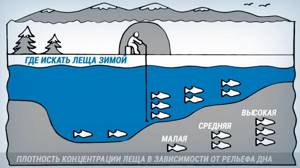
At first, finding fish may seem too difficult, because the area being fished covers a large area. But as the half-kill bream pecks, this area narrows. You shouldn’t waste time and energy on “dead” holes.
If the activity of the “plywood” is very low, you can try shaking a small jig with a bunch of bloodworms. There is no need to try fishing with a hanging jig or fishing from the bottom. This fishing is exploratory and by fishing different layers with frequent movements, there is a greater chance of finding good fish.
Since during the day the average size of trophies is much smaller, you need to focus on the outcrops of large undergrowth. If you can understand how it behaves during the day, it will become easier to catch it at night. And seasoned bream is always next to a school of bream. Therefore, having identified several “shot” holes during the day, all that remains is to choose the best one.
During prolonged thaws, the movement of bream throughout the reservoir becomes more active. These days it is better to look for it in the so-called watering areas, places where roaches are caught in winter. These are flat muddy areas with an average depth of 4–5 meters and a flat bottom. If the warming is strong and melt water begins to get into the holes, the bream will probably be at half-water. It will be useless to fish from the bottom even at night; it is better to fish by shaking, especially by lowering the jig.
Unfortunately, despite the fact that bream begin to move more during the thaw, the bite is short-lived. Bites often look like an uncertain pressure of the nod, whereas in cold weather there are very confident rises.
Note! The task of an experienced fisherman is to discover bream trails. It is known that this schooling fish strictly adheres to certain routes.
Alas, if you happen to be far from the fish road, then most likely the night trophy will only be small “plywood” and it will not be a matter of groundbait, fishing line or bait. We can say that without knowledge of the reservoir, at least approximately, fishing completely turns into a lottery.
☸ Lighting and heating
At night and on cloudy days you cannot do without sources of artificial light. For short fishing (for example, from lunch to evening), you can take two or three candles. They are enough to maintain sufficient visibility inside the tent for several hours. In addition to light, a burning candle provides warmth. If you plan to fish for many days, then you will need something more serious. An excellent choice would be any LED device with a long resource (lantern, lamp). You can also use a gas or kerosene lamp, which also provides light and heat at the same time. True, this outdated device produces a fair amount of smoke, so the heat it produces will be lost due to constant ventilation.
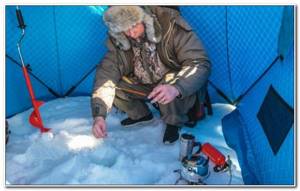
In severe frost, candles or dry alcohol alone will not heat up a tent, especially a multi-person tent. If weather forecasters predict a significant drop in temperature, you should take a camp burner or some kind of heater that runs on gas (gasoline) for fishing. The fuel supply is determined taking into account how much time the fisherman plans to spend on the pond.
☸ You can buy winter fishing tents at low prices HERE.
For a long overnight stay in a single-layer tent, you can use this option:
You need to assemble a tent at home in a hall or other spacious room and cover it with plastic film that has good density and width. If you manage to assemble it into some kind of tent cover, you can then glue the cut edges together using an iron. To do this, sheets of newspaper are placed on the edges of the film, laid overlapping, and you can run an iron over them several times, observing the temperature regime so that the polyethylene does not melt and the edges stick together.

If the plastic film does not fold into a cover, then you can cut it into wedges, pinning it to the tent with pins as a bait pattern. Having walked in a circle and collected the wedges into something like a tent cover, you can then glue them together using the above method using an iron.
You can take the polyethylene cover with you on an overnight fishing trip. And then a single-layer tent, which is well lit and easily transported from place to place, will become a completely insulated shelter if you put a plastic cover on it in the evening. The edges of the cover must be sprinkled with snow and then the tent will be warm with some kind of heater installed inside. But you should definitely remember, despite the wind and frost, the window of the tent when using a gas stove to heat your home should always be slightly open. Otherwise, even in a tent you can get carbon monoxide poisoning, which already happened last season, when fishermen were poisoned by carbon monoxide and then burned in a fire that started from a gas stove. Therefore, after gluing the polyethylene cover, you must also cut out a window in it opposite the window of the tent and do not forget about the “door”.
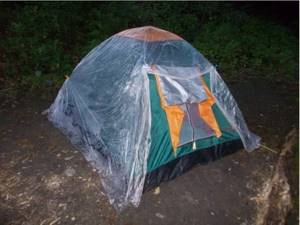
It is best to heat the tent using a gas stove with a ceramic burner. With such a burner there is no open fire, but the heating temperature of the burner allows you to boil water and heat the tent.
Share with your friends!
Types of tents for ice fishing
Many types of tents are suitable for ice fishing. Some originals go out onto the pond with single-layer summer shelters “made in China” for 1 thousand rubles, cut a hole in the floor for a hole and are quite satisfied.
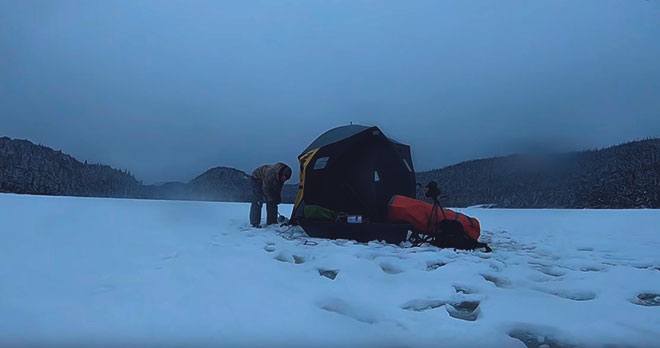
But there is a small correction: such shelters are used as a base camp. And such a tent is enough for 2-3 outings. But let's not go to extreme extremes. It’s better to consider options for shelters designed for comfortable winter fishing.
Umbrella
The hexagon-shaped tent unfolds like an umbrella. The walls are located at an angle of 45 degrees relative to the ice surface. The frame consists of strong, rigid aluminum rods. The awning is made of canvas or, more often, synthetic fiber.
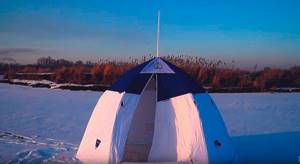
Tent umbrella.
Advantages:
Even a beginner can quickly assemble and disassemble;
- not heavy;
- stable, due to the inclined walls (the wind does not blow away such a tent, but only presses it to the ground);
- warms up quickly.
Flaws:
- it’s impossible to turn around inside due to the cramped space, so the fisherman has to sit strictly in the center;
- only single or double tents are produced (and a double umbrella tent can hardly accommodate two people);
- a synthetic awning practically does not “breathe”, which is why the tent needs frequent ventilation.
Frame
Shaped like a tourist tent. The functions of the frame are performed by rigid arcs threaded through the hinges of the awning and installed crosswise.
Advantages:
- resistance to gusts of wind;
- spaciousness;
- warms up well.
Flaws:
- large weight and dimensions;
- assembly takes a lot of time, which is why the frame shelter is not suitable for “wandering” around a pond.
Cube
The best automatic tent for winter fishing. It is presented in the form of a cubic house with walls convex outward. An awning made of heat-saving material with fire-resistant impregnation. There are transparent ventilation windows that provide high illumination inside the shelter.
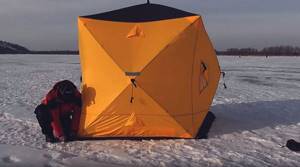
Winter tent Cube.
Advantages:
- spaciousness: you can stand up to your full height and even walk around a little;
- rigid fiberglass frame;
- no condensation on the roof.
Flaws:
- windage: a strong gust of wind can blow away the tent;
- one of the most expensive types of tents.
Machine
An automatic tent or a spring tent is an option for one-day winter fishing. For expensive models, the awning is attached to an elastic, strong base. In cheaper tents, the frame is made of a material with low rigidity, which is why it is not able to withstand the wind and breaks quickly. Installs in 10 seconds, using the spring principle.
Advantages:
- mobility;
- quick installation and dismantling;
- wind resistance (expensive models);
- light weight.
Flaws:
- the frame may break if folded incorrectly;
- Tents with a rigid base are very expensive.
Trekking tents
Designed for multi-day bike tours, the shelter is suitable for one-day ice fishing. As a rule, it has a hexagon shape. The awning is made of wind-resistant material. The frame consists of numerous, lightweight but durable fiber plastic arches.
Advantages:
- high degree of ventilation;
- the frame is assembled in less than a minute;
- a light weight.
Flaws:
- in case of strong wind, additional guy ropes are installed;
- a two-person tent is a bit cramped for two people when it comes to night fishing.
